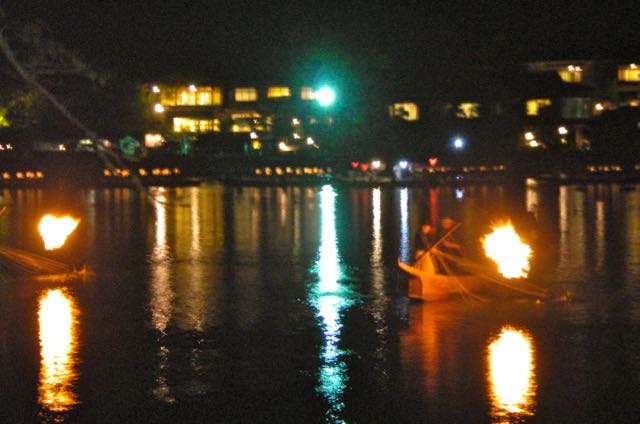 by Anne Harrison
by Anne Harrison
He led me to a bridge, carrying in his arms with him certain dive-droppers or water-fowls, bound to perches and about every one of their necks he tied a thread, lest they should eat the fish as fast as they took them. He loosened the dive-droppers from the pole, and within less than the space of one hour, caught as many fish as filled three baskets; which being full, my host untied the threads from about their necks, and entering the second time into the river they fed themselves with fish, and being satisfied, they returned and allowed themselves to be bound to their perches, as they were before.
So wrote the Franciscan monk Friar Oderic as he wandered barefoot across Asia in 1321. Apart from wearing shoes, little, it seems, has changed. A fat orange moon climbed into view as we crossed the Togersu-kyo, or Moon Bridge. Small balls of fire floated across the bay: the fishing had begun.
I first heard of cormorant fishing in infant school, sitting cross-legged on the floor and listening in wonder as our grey-haired teacher recounted her travels through exotic lands. Her tale of seeing the cormorants fish in Japan has stayed with me. It was a story belonging to an age long gone, to an enchanted time when magical things could happen.
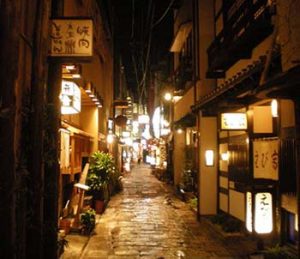 Little more than a fishing village, Arashiyama is only twenty minutes from Kyoto. We were staying on the outskirts of the city, and as darkness fell we stood waiting in a pool of light on a deserted street, with only the sounds of crickets and frogs for company. As if straight from an anime an empty bus arrived, its lights bright against the night, and we wound through out-lying suburbs already closed for the night. Light from the occasional shop fell onto the street, and we passed tiny restaurants barely large enough to feed half a dozen locals. The driver announced each stop in a voice borrowed from Barry White.
Little more than a fishing village, Arashiyama is only twenty minutes from Kyoto. We were staying on the outskirts of the city, and as darkness fell we stood waiting in a pool of light on a deserted street, with only the sounds of crickets and frogs for company. As if straight from an anime an empty bus arrived, its lights bright against the night, and we wound through out-lying suburbs already closed for the night. Light from the occasional shop fell onto the street, and we passed tiny restaurants barely large enough to feed half a dozen locals. The driver announced each stop in a voice borrowed from Barry White.
(Never quite sure where I was going, somehow every bus I caught in Japan took me to the right place, as if the drivers knew better than I did where I was heading. On one, I met a group of young Austrians so busy watching their GPS to find the right stop, they barely glanced out the window.)
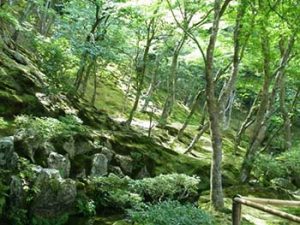 Finally, the bus stopped. Arashiyama seemed asleep. Against the darkness of the surrounding hills, lights twinkled from restaurants hiding on the other side of the bay. Coloured lights lit the narrow streets, and lanterns hung amongst the trees leading down to the water.
Finally, the bus stopped. Arashiyama seemed asleep. Against the darkness of the surrounding hills, lights twinkled from restaurants hiding on the other side of the bay. Coloured lights lit the narrow streets, and lanterns hung amongst the trees leading down to the water.
Marco Polo witnessed ukai (or cormorant fishing) in China, but it is first mentioned in a chronicle dating from the Sui Dynasty (A.D. 581-618): In Japan they suspend small rings from the necks of cormorants, and have them dive into the water to catch fish. In one day they can catch over a hundred.
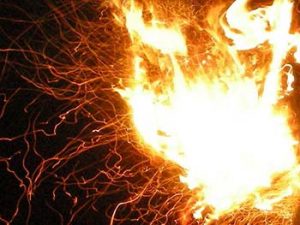 Barely visible in the darkness, small wooden boats floated across the water, much as they have done for the last thirteen hundred years. These ubune have flat bottoms so as to glide easily over the shallow bay. A metal brazier hangs over the front, and I could hear the sizzle and snap of the burning wood as sparks showered over the water. Most boats carry three fishermen; the usho, (or leader), who handles the cormorants as they dive for fish; the nakanori (or middle rider), who collects the fish from the birds, and the tomonori (or companion rider), who guides the boat. They still wear the traditional dark kimono, a straw skirt to repel water, and a linen cloth wrapped around their heads to protect them from sparks.
Barely visible in the darkness, small wooden boats floated across the water, much as they have done for the last thirteen hundred years. These ubune have flat bottoms so as to glide easily over the shallow bay. A metal brazier hangs over the front, and I could hear the sizzle and snap of the burning wood as sparks showered over the water. Most boats carry three fishermen; the usho, (or leader), who handles the cormorants as they dive for fish; the nakanori (or middle rider), who collects the fish from the birds, and the tomonori (or companion rider), who guides the boat. They still wear the traditional dark kimono, a straw skirt to repel water, and a linen cloth wrapped around their heads to protect them from sparks.
We crossed the Moon Bridge just as the cormorant boats set off across the bay. Still in a state of disbelief, I walked closer to the bay, expecting to pass some Omiyabito (or court nobles) sitting by the shore, as they did every summer in the Heian Era (794 to 1185 AD). Their arrival to watch the cormorant fishing marked the start of summer.
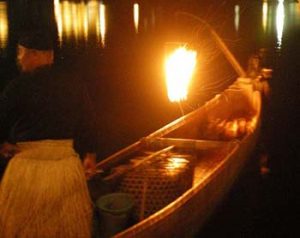 Once darkness falls and the moon rises, the boats spend the evening passing back and forth across the bay. Some half-dozen tourist barges lay moored in the middle of the bay, much as the wealthier omiyabito had of old. The fishermen guided the ubune past them with great theatrical display, and the sounds of applause and cheers floated across the water. We found a spot away from the other tourists on a landing stage which ran into the bay. Watching the boats from here was akin to seeing a performance from behind the curtains of a grand stage; I could easily see the small metal ring around each cormorant’s neck.
Once darkness falls and the moon rises, the boats spend the evening passing back and forth across the bay. Some half-dozen tourist barges lay moored in the middle of the bay, much as the wealthier omiyabito had of old. The fishermen guided the ubune past them with great theatrical display, and the sounds of applause and cheers floated across the water. We found a spot away from the other tourists on a landing stage which ran into the bay. Watching the boats from here was akin to seeing a performance from behind the curtains of a grand stage; I could easily see the small metal ring around each cormorant’s neck.
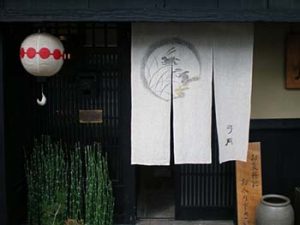 Attracted by the light from the brazier, fish swim close to the boat. With a splash the cormorants tumbled into the water. They can swallow small fish quite easily, but the ring prevents them swallowing anything larger – these they bring back to the boat, often given a smaller fish as a reward. A leash is attached to their collar, and with some dozen cormorants per boat, it takes remarkable skill on behalf of the usho to prevent these leashes from becoming a tangled mess. When enough fish had been collected, the birds rested on the sides of the boat, silhouetted against the light of the brazier as they stretched their wings to dry.
Attracted by the light from the brazier, fish swim close to the boat. With a splash the cormorants tumbled into the water. They can swallow small fish quite easily, but the ring prevents them swallowing anything larger – these they bring back to the boat, often given a smaller fish as a reward. A leash is attached to their collar, and with some dozen cormorants per boat, it takes remarkable skill on behalf of the usho to prevent these leashes from becoming a tangled mess. When enough fish had been collected, the birds rested on the sides of the boat, silhouetted against the light of the brazier as they stretched their wings to dry.
Matsuo Basho (1644-1694 AD) remains the most famous poet of the Edo Period, and today is revered in Japan for his haiku. On seeing the cormorant fishing he wrote:
Exciting to see
But soon after comes sadness
The cormorant boats.
If You Go:
International flights to Japan arrive in Kansai International Airport, near Osaka.
Both trains and buses run from either the airport or Osaka to Kyoto. From Tokyo, Kyoto is easily reached by train.
Travelling Around Japan
Hostels offer a cheaper alternative for accommodation in Japan; otherwise, why not try a typical ryokan?
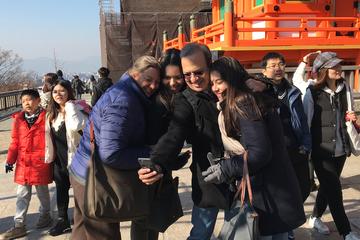
Kyoto Temple, Shrine, Geiko & Sake Tour – $175.09
from: Viator
About the author:
Anne Harrison lives with her husband, two children and numerous pets in regional Australia. She discovered travel at the age of ten, then the world of history and philosophy. Her jobs include wife, mother, doctor, farmer, cheese-maker and local witch doctor, and her ambition is to be 80 and happy. Read more at anneharrison.com.au and hubpages.com/@anneharrison.
All photos copyright Anne Harrison:
Balls of fire setting off across the bay
The night streets of Kyoto
A quiet spot in Arashiyama
Fire from a brazier
The usho in his traditional kimono
Typical entrance to a restaurant

